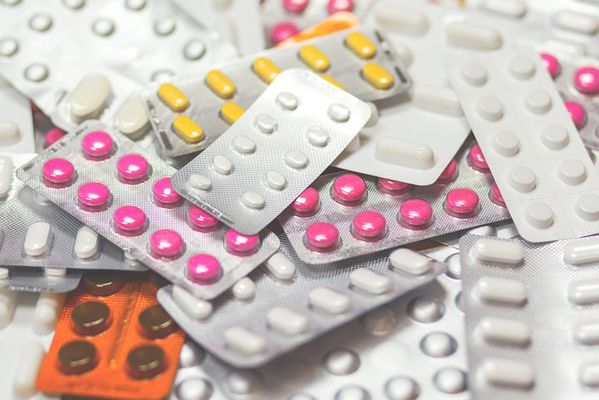10.1.4
Malaria
Malaria
Malaria
Malaria is a disease caused by Protoctista, resulting in cyclical symptoms of fever, chills and ultimately death if left untreated. The parasite can also use birds, bats and other animals as hosts.


Pathogen
Pathogen
- Malaria is caused by several species of the Plasmodium genus.
- P. falciparum causes the most malarial deaths worldwide.
- P. vivax, P. ovale, P. malariae and P. knowlesi are much rarer, but P. vivax can remain in the liver for years without causing symptoms.
- The parasite grows and multiplies in erythrocytes, causing them to burst every 2-3 days, releasing Plasmodium into the bloodstream.


Treatment
Treatment
- Malaria is treated using antimalarial medication such as Doxycycline and Mefloquine.
- A preventative course of this medication should be taken prior to travel to known high-risk regions - this can reduce the risk of malaria by up to 90%.
- Different antimalarial medication can be used to treat the disease if the preventative course does not work.


Transmission
Transmission
- Malaria is transmitted by insect vectors, specifically the female Anopheles mosquito when it takes a blood meal from an infected person.
- Malaria is most common in Africa, Asia and South America because the climate is suitably warm for the mosquito to live in and the probability of biting an infected person is higher.


Prevention
Prevention
- Removing the insect vector is 100% effective in preventing transmission, although this is not always practical on a large scale.
- Sleeping under mosquito nets, applying insect repellent and covering exposed skin help reduce the risk of being bitten in the first place.
- Developing countries are particularly affected by malaria. Funding from governments or charities is often required to provide mosquito nets.


Location
Location
- The mosquito vector for malaria requires warm, damp conditions to survive.
- This limits the disease to hot, humid countries near the equator.
1Cell Structure
1.1Cell Structure
1.1.1Studying Cells - Microscopes
1.1.2Introduction to Eukaryotic & Prokaryotic Cells
1.1.3Ultrastructure of Eukaryotic Cells
1.1.4Ultrastructure of Eukaryotic Cells 2
1.1.5Ultrastructure of Eukaryotic Cells 3
1.1.6Prokaryotic Cells
1.1.7Viruses
1.1.8End of Topic Test - Cell Structure
1.1.9Exam-Style Question - Microscopes
1.1.10A-A* (AO2/3) - Cell Structure
2Biological Molecules
2.1Testing for Biological Modules
2.2Carbohydrates & Lipids
2.3Proteins
3Enzymes
4Cell Membranes & Transport
4.1Biological Membranes
5The Mitotic Cell Cycle
6Nucleic Acids & Protein Synthesis
6.1Nucleic Acids
7Transport in Plants
8Transport in Mammals
8.1Circulatory System
8.2Transport of Oxygen & Carbon Dioxide
9Gas Exchange
9.1Gas Exchange System
10Infectious Diseases
10.1Infectious Diseases
10.2Antibiotics
11Immunity
12Energy & Respiration (A2 Only)
13Photosynthesis (A2 Only)
14Homeostasis (A2 Only)
14.1Homeostasis
14.2The Kidney
14.3Cell Signalling
14.4Blood Glucose Concentration
14.5Homeostasis in Plants
15Control & Coordination (A2 Only)
15.1Control & Coordination in Mammals
15.1.1Neurones
15.1.2Receptors
15.1.3Taste
15.1.4Reflexes
15.1.5Action Potentials
15.1.6Saltatory Conduction
15.1.7Synapses
15.1.8Cholinergic Synnapses
15.1.9Neuromuscular Junction
15.1.10Skeletal Muscle
15.1.11Sliding Filament Theory Contraction
15.1.12Sliding Filament Theory Contraction 2
15.1.13Menstruation
15.1.14Contraceptive Pill
15.2Control & Co-Ordination in Plants
16Inherited Change (A2 Only)
16.1Passage of Information to Offspring
16.2Genes & Phenotype
17Selection & Evolution (A2 Only)
17.2Natural & Artificial Selection
18Classification & Conservation (A2 Only)
18.1Biodiversity
18.2Classification
19Genetic Technology (A2 Only)
19.1Manipulating Genomes
19.2Genetic Technology Applied to Medicine
19.3Genetically Modified Organisms in Agriculture
Jump to other topics
1Cell Structure
1.1Cell Structure
1.1.1Studying Cells - Microscopes
1.1.2Introduction to Eukaryotic & Prokaryotic Cells
1.1.3Ultrastructure of Eukaryotic Cells
1.1.4Ultrastructure of Eukaryotic Cells 2
1.1.5Ultrastructure of Eukaryotic Cells 3
1.1.6Prokaryotic Cells
1.1.7Viruses
1.1.8End of Topic Test - Cell Structure
1.1.9Exam-Style Question - Microscopes
1.1.10A-A* (AO2/3) - Cell Structure
2Biological Molecules
2.1Testing for Biological Modules
2.2Carbohydrates & Lipids
2.3Proteins
3Enzymes
4Cell Membranes & Transport
4.1Biological Membranes
5The Mitotic Cell Cycle
6Nucleic Acids & Protein Synthesis
6.1Nucleic Acids
7Transport in Plants
8Transport in Mammals
8.1Circulatory System
8.2Transport of Oxygen & Carbon Dioxide
9Gas Exchange
9.1Gas Exchange System
10Infectious Diseases
10.1Infectious Diseases
10.2Antibiotics
11Immunity
12Energy & Respiration (A2 Only)
13Photosynthesis (A2 Only)
14Homeostasis (A2 Only)
14.1Homeostasis
14.2The Kidney
14.3Cell Signalling
14.4Blood Glucose Concentration
14.5Homeostasis in Plants
15Control & Coordination (A2 Only)
15.1Control & Coordination in Mammals
15.1.1Neurones
15.1.2Receptors
15.1.3Taste
15.1.4Reflexes
15.1.5Action Potentials
15.1.6Saltatory Conduction
15.1.7Synapses
15.1.8Cholinergic Synnapses
15.1.9Neuromuscular Junction
15.1.10Skeletal Muscle
15.1.11Sliding Filament Theory Contraction
15.1.12Sliding Filament Theory Contraction 2
15.1.13Menstruation
15.1.14Contraceptive Pill
15.2Control & Co-Ordination in Plants
16Inherited Change (A2 Only)
16.1Passage of Information to Offspring
16.2Genes & Phenotype
17Selection & Evolution (A2 Only)
17.2Natural & Artificial Selection
18Classification & Conservation (A2 Only)
18.1Biodiversity
18.2Classification
19Genetic Technology (A2 Only)
19.1Manipulating Genomes
19.2Genetic Technology Applied to Medicine
19.3Genetically Modified Organisms in Agriculture
Unlock your full potential with Seneca Premium
Unlimited access to 10,000+ open-ended exam questions
Mini-mock exams based on your study history
Unlock 800+ premium courses & e-books